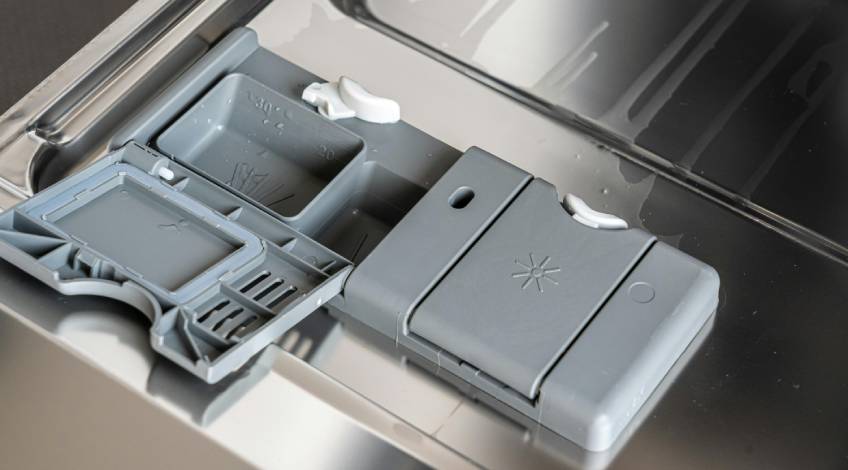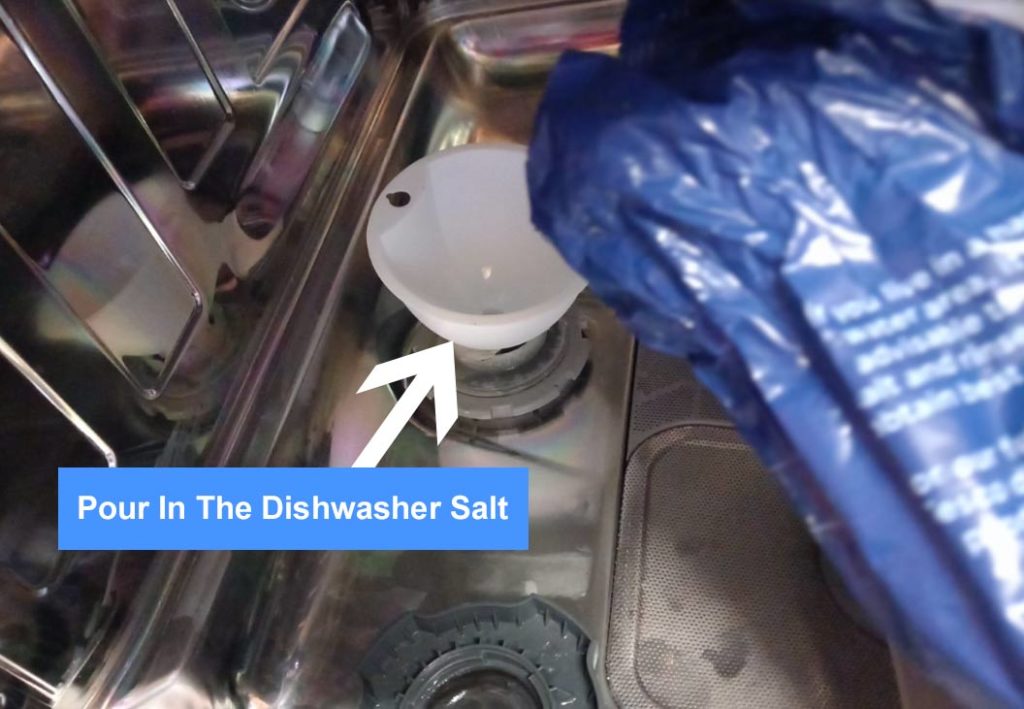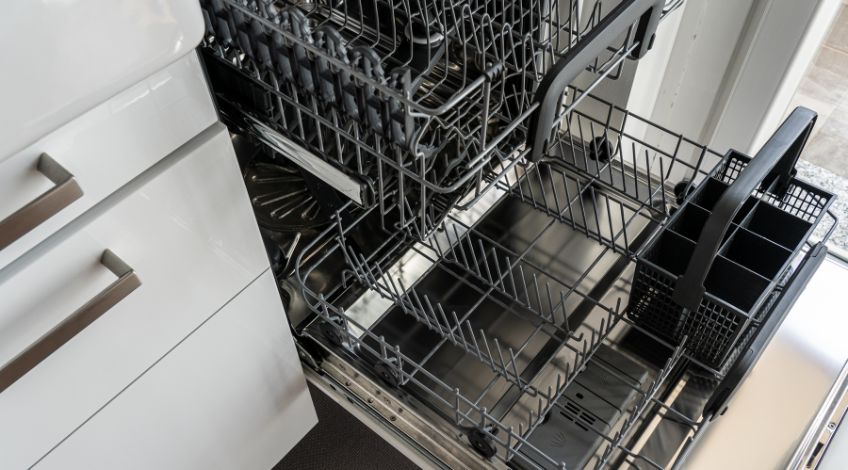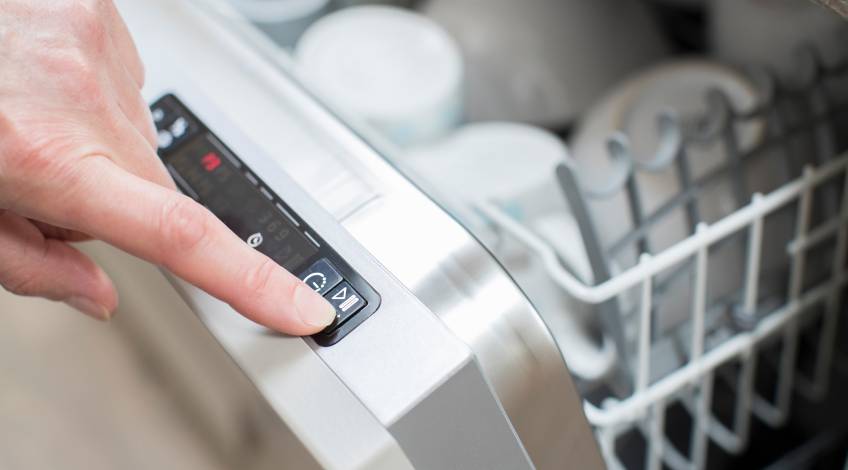
Whirlpool Dishwasher Not Cleaning? (here’s why & what to do)
Dishwashers are great labour saving devices, you load all of your dirty dishes into the racks, select a wash cycle and the dishwasher does the rest. Allowing you to get on with your life without having to do the dishes.
However, if your dishwasher starts malfunctioning in some way and developing a problem, it can be worrying. One such problem is the dishes not coming out very clean after the dishwasher has finished. If you own a Whirlpool dishwasher and it’s not cleaning the dishes to a satisfactory level, keep reading.
In this article we take a close look at all of the reasons why your Whirlpool dishwasher might not be getting your dishes as clean as they should be.
Why Is My Whirlpool Dishwasher Not Cleaning?
There are a number of reasons why your Whirlpool dishwasher might not be cleaning properly which include;
| Probable Cause | Solution |
|---|---|
| Cramming Too Many Dishes Into The Racks | Ensure dishes are loaded correctly |
| Using Too Much Or The Wrong Type Of Detergent | Ensure that you use the correct type of detergent in the right quantity |
| Blocked Or Damaged Detergent Dispenser | Check, clean and replace the detergent dispenser if necessary |
| No Rinse Aid | Ensure the rinse aid dispenser is topped up regularly |
| No Dishwasher Salt | Ensure The Dishwasher salt reservoir is topped up regularly |
| Defective Water Inlet Valve | Check and replace the inlet valve if necessary |
| Wrong Cycle Selected | Choose a hotter wash cycle |
| Clogged Filter | Remove and clean the filter |
| Defective Turbidity Sensor | Check and replace the turbidity sensor if necessary |
| Problems Associated With The Spray Arms | Inspect the spray arms, clean and remove any blockages |
| Low Water Pressure | Contact the local water authority |
Let’s take a closer look at each of these issues;
Cramming Too Many Dishes Into The Racks

If you cram too many dishes into the racks of your dishwasher, it prevents water from flowing all around each and every dish. This will greatly reduce the chances of every dish getting properly cleaned.
It also increases the chances of items protruding through the racks which can prevent the spray arms from turning properly.
There is also the possibility of placing dishes in the dishwasher incorrectly which can prevent them getting clean properly. The racks in the dishwasher should be stacked in the following way;
Upper Rack
You should place cups, glassware and bowls face down on the upper rack. Ensure there is sufficient space between each item to allow proper water flow.
Lower Rack
You should place plates facing inwards in the lower rack allowing one space per each plate. Cookware (saucepans) should also be placed on the lower rack face down.
Cutlery Rack
Items of cutlery should be placed in the cutlery rack alternately to avoid nesting. Each item should be placed upright and not sloping.
Take care that nothing impedes the movement of the spray arms and place large utensils on the top rack, laying flat.
Using Too Much Or The Wrong Type Of Detergent
This is one of the most common causes of dishes not getting cleaned properly in the dishwasher. Make sure to always use the best quality dishwasher detergent you can.
This will typically be made from a blend of soap, enzymes and rinse aid. Which are all designed to work together to remove food stains, and reduce hard water deposits and streaks on your dishes.
If you add too much detergent to the dispenser it can lead to the dispenser becoming clogged with detergent residue. This will eventually prevent the dispenser from opening at the correct time which will also prevent the dishes from getting cleaned properly.
Blocked Or Damaged Detergent Dispenser

We just mentioned the possible problems that using too much or the wrong type of detergent can cause, especially relating to the detergent dispenser.
In some cases, the dispenser cannot open due to a pan handle or utensil blocking it. You need to pay close attention to the placement of your dishes and utensils to prevent this kind of problem.
However, sometimes the dispenser can become damaged, typically due to detergent residue sticking to the dispenser door mechanism. Old age and wear and tear can also cause the same issue.
If you suspect the detergent dispenser is damaged, we recommend contacting a technician to investigate and replace it if necessary. If the dispenser is just dirty and clogged with detergent residue, you can clean it using warm water and a toothbrush.
No Rinse Aid
Rinse aid isn’t just used to make dishes look shiny and sparkling. It actually breaks the surface tension of the individual water droplets which helps in both cleaning and rinsing the dishes.
If your dishwasher needs rinse aid, the first sign you get could be dirty dishes or dishes that aren’t cleaned properly. Always ensure the rinse aid dispenser is topped up regularly.
No Dishwasher Salt

Dishwashers rely on soft water to run effectively. Sadly, much of the UK is supplied with hard water, that’s water containing naturally occurring minerals like calcium and magnesium.
These minerals prevent the dishwasher from functioning correctly. Which is why it is important to keep the dishwasher salt reservoir topped up regularly. Dishwasher salt is necessary in trapping and removing the mineral content from the water.
This means the dishwasher will clean better and run smoother if it has a steady supply of dishwasher salt.
Defective Water Inlet Valve
All of the water that enters your dishwasher does so via the inlet valve. Over time the inlet valve could become defective and develop a fault.
This could slow the flow of water into the appliance resulting in your dishes not getting cleaned properly.
If you suspect the inlet valve is the cause of your dishwasher’s problems, we recommend getting a technician to investigate and replace the inlet valve for you.
Wrong Cycle Selected
If your dishes are heavily soiled and you select a short wash at a low temperature, the dishes will still have dirty patches after the cycle has completed.
You need to select the correct cycle for the levels of dirt on your dishes. This could be the reason why your dishes aren’t cleaning properly. Try a longer, hotter cycle and see if it makes a difference.
Clogged Filter
The filter on your dishwasher is designed to trap and prevent any food particles or other debris from returning to the now clean dishes or damaging any components on the dishwasher.
If the filter is clogged, it can impede the flow of water through the appliance and even result in the dishes being washed in dirty water.
You should clean the filter at least once per month to remove any debris, Consult your user manual on the location and correct way to remove the filter from your Whirlpool dishwasher.
Defective Turbidity Sensor
The turbidity sensor detects the level of dirt in the water of your dishwasher. This determines how long the wash and rinse cycles run for.
If the turbidity sensor becomes defective, the dishwasher could use dirty water to wash and/or rinse the dishes.
We recommend getting a technician to investigate and replace the turbidity sensor if necessary.
Problems Associated With The Spray Arms

All of the water distributed through your dishwasher runs through the spray arms. We already mentioned how the spray arms can become impeded by plates, pans and utensils preventing them from turning freely.
Other problems with the spray arms include, dirty or clogged nozzles which can be cleaned using warm soapy water and any blockages in the nozzles can be prised out using a toothpick. Take care that you don’t force the blockage further into the nozzle.
Then there’s the possibility of damage which can happen over time. The spray arms can become cracked which would then affect the water flow and result in your dishes not getting cleaned properly.
Low Water Pressure
Your dishwasher needs a water pressure of at least 20 psi (pounds per square inch) to function properly. Low water pressure would result in your dishes not getting clean properly.
There are several reasons why the water pressure might be low, which include;
Defective Inlet Valve
We already mentioned some of the problems associated with a defective inlet valve. But it wouldn’t be right if we never covered it here as well.
If the inlet valve isn’t allowing water into the dishwasher at a fast enough rate, it will result in low water pressure. As we said earlier, this is a job best left to a technician to investigate and replace if necessary.
Inlet Tap Not Fully Open
In some cases, low water pressure can be caused by not opening the inlet tap fully. The inlet tap can be found at the back of the appliance attached to the inlet hose.
If the tap isn’t fully opened, the water will not flow at a fast enough rate which could leave dishes dirty or not rinsed correctly. All you need to do is fully open the inlet tap to solve this issue.
Stopcock Not Open Fully
If you have recently had some plumbing work done in your home, it’s possible that the plumber never fully opened the stopcock when the work was completed.
The stopcock controls all of the water that enters your home and is often located under the kitchen sink. Try opening the stopcock further and see if this helps get the dishes clean in the dishwasher.
Issues With The Water Supply
If you have checked everything else, all that’s left is the actual water supply. You can check whether the water supplied to your home is of an adequate pressure by doing the following;
- Fill a 1 gallon (4.5 litre) bucket with water from the cold tap in your kitchen
- Time how long it takes to fill – If it is 30 seconds or less, the water pressure is fine
- If it takes more than 30 seconds to fill the bucket, your water is being supplied at low pressure. If this is the case, you will need to contact your local water authority.
Whirlpool Dishwasher Diagnostics

Your Whirlpool dishwasher has a diagnostic system that can make checking for any problems an easier task. Armed with the knowledge gathered from the diagnostics on your Whirlpool dishwasher, you will be able to give the technician a much better picture of what is going on.
To access the diagnostics on your Whirlpool dishwasher you need to;
- Press and hold the heated dry button for 5 seconds
- Then press the normal button once and wait
- The dishwasher should now enter the diagnostic mode
Once in the diagnostic mode, the dishwasher will display any error codes it has detected. You can then check these against the list in your user manual to understand what problems the dishwasher is having.
Whilst in diagnostic mode, your dishwasher allows you to test each component. You will get the information needed to check the dishwasher’s components via prompts on the display screen.
Once you have completed these tests, you can exit the diagnostic mode by pressing the cancel button. If you do nothing whilst in diagnostic mode for a total of 4 minutes, the dishwasher will automatically exit the diagnostic mode.
How To Reset A Whirlpool Dishwasher
If you need to reset your Whirlpool dishwasher to clear an error code, you need to make sure it is in standby mode first. Then; Press the heated dry and normal buttons one after the other twice.
If you successfully pressed the buttons in the correct sequence, the control panel should light up as the dishwasher starts to reset.
How To Run A Cleaning Cycle On A Whirlpool Dishwasher
To ensure that your Whirlpool dishwasher runs properly, it is best practice to keep it as clean as possible. To run a cleaning cycle on a Whirlpool dishwasher, all you need to do is;
- Ensure The Dishwasher Is Empty
Remove all dishes, utensils and any other items from the dishwasher.
- Add Some Type Of Cleaning Agent
Place a dishwasher cleaning tablet or a bowl of white vinegar or a proprietary dishwasher cleaner in the dishwasher. - Run The Clean Cycle
Close the dishwasher door and select the clean cycle on the control panel. If your model doesn’t have a clean cycle, select the hottest and longest wash cycle available. - Wipe The Interior
Once the cycle has finished, open the door and wipe all of the interior including around the detergent dispenser and door seal with a cloth to remove any residue that’s remaining. - Run A Rinse Cycle
After wiping down, close the door and run a rinse cycle to ensure all of the residue has been washed away.
This should be repeated at least once per month to ensure your Whirlpool dishwasher remains in tip top condition.
SEE ALSO: Whirlpool Dishwasher Diagnostic Mode Explained
Frequently Asked Questions
If your Whirlpool dishwasher is working but not cleaning your dishes, it could be because; the filter is clogged, you have incorrectly loaded the dishes, the detergent is of inferior quality, the rinse aid dispenser needs topping up, the dishwasher salt reservoir needs topping up, the water inlet valve is faulty, you have selected the wrong cycle, there is a problem with the spray arms or the dishwasher is being supplied with water at a low water pressure.
You can reset your Whirlpool dishwasher by pressing the heated dry and normal buttons one after the other twice. If done correctly, the dishwasher panel should light up as the appliance starts to reset.
To enter the diagnostic mode on a Whirlpool dishwasher all you need to do is press and hold the heated dry button for 5 seconds, then press the normal button once and wait. The dishwasher should now enter the diagnostic mode.




